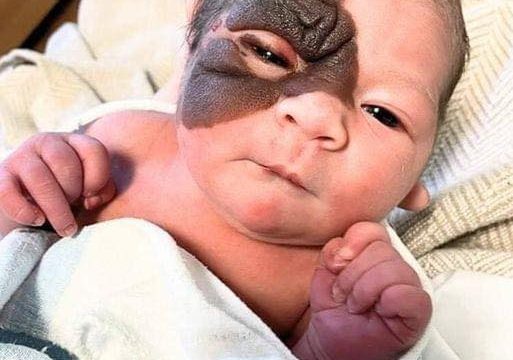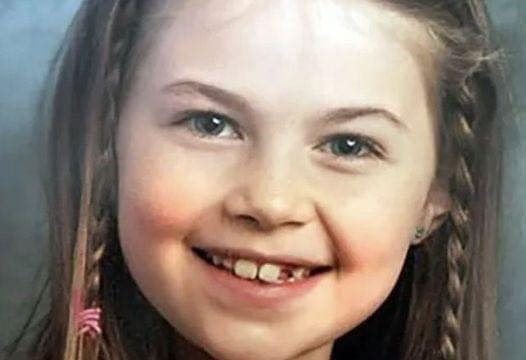Only weeks after Millie Smith and her partner, Lewis Cann, learned they were expecting twin baby girls, their joy turned into heartbreak when they were informed that only one twin would survive.
On April 30, after 30 weeks of a challenging and high-risk pregnancy, Millie gave birth to identical twin daughters, Callie and Skye. Tragically, Skye lived for only three precious hours.

In the neonatal intensive care unit (NICU), Callie lay in her incubator without her sister, while her parents lovingly watched over her, grappling with their grief. Surrounded by other newborns, an overwhelmed mother of healthy twins made a seemingly innocent comment to Millie, saying she was “so lucky” to not have two babies.
The words were crushing. Millie, unable to find the strength to explain her loss, realized that Skye’s legacy could be one of compassion and understanding, and the idea for the purple butterfly was born.
In November 2015, Millie and Lewis received the wonderful news that they were expecting their first child. Millie, who has a family history of twins, had a strong intuition that she might be carrying two babies. Her instincts were confirmed ten weeks later when doctors revealed she was expecting identical twin girls.
However, the couple’s excitement was short-lived. Less than two weeks after receiving the happy news, their world was turned upside down when doctors discovered that one of their babies had a fatal condition and would not survive after birth.
“During the scan, the doctor didn’t say anything,” Millie recalled. “I was so excited to see the little babies, but her silence was alarming. Both Lewis and I immediately knew something was wrong.”
Doctors explained that one of the twins had anencephaly, a severe birth defect in which parts of the brain and skull are missing. According to the Centers for Disease Control and Prevention (CDC), this condition affects about one in 4,600 babies in the United States, and almost all infants born with anencephaly pass away shortly after birth.
Despite knowing that one of their babies would not survive and the risks posed to the other twin, Millie and Lewis made the difficult decision to continue with the high-risk pregnancy. Over the following months, they chose meaningful names for their daughters: Skye and Callie.
“We wanted Skye to have her name before she was born,” Millie explained. “Knowing her time with us would be so brief, it was important that she had a name during those moments.” The name “Skye” held special meaning, symbolizing a place where they could always look up and remember their daughter.
At just 30 weeks, Millie went into labor and had to undergo an emergency C-section. To help them cope with the impending loss, the couple was supported by a bereavement midwife and placed in a special “Daisy Room,” a space designed for families to spend time with their baby before and after passing.
“When the girls were born, they both cried,” Millie shared. “This was an incredible moment because we were told Skye might not make a sound or move. We were able to hold her for three precious hours before she passed away. That was the hardest moment of our lives. The heartbreak was unimaginable, but I am proud that she fought to spend time with us.”
Callie, born prematurely, remained in the NICU to gain strength. The unit housed three other sets of twins. While most nurses knew what had happened, over time, fewer people spoke about Skye. This led to a heartbreaking moment when another mother, whose twins were also in the NICU, made an offhand comment, telling Millie she was “lucky” not to have two babies.
“Her comment was innocent and meant as humor,” Millie said. “She didn’t know what had happened, but it shattered me. I ran out of the room in tears. I didn’t have the heart to explain what had occurred. A simple sticker could have prevented the situation entirely.”
It was in that moment Millie realized she needed to create something that could quietly communicate a family’s loss to others. She designed a poster for NICUs, explaining that any incubator with a purple butterfly on it indicated that one or more babies in a set of multiples had been lost.
“I chose butterflies to represent the babies who flew away, and purple because it is a color suitable for both boys and girls,” Millie said.
What started as a simple idea has now grown into a global movement. The purple butterfly initiative, part of the Skye High Foundation, has been adopted by hospitals worldwide to support grieving families.
Today, Callie is a lively seven-year-old, and Skye’s memory lives on through purple butterfly cards and other initiatives, including ornaments, blankets, stuffed animals, and more. The foundation continues to expand its support for families who have endured similar losses.
“Losing a child is the hardest thing anyone can face,” Millie said. “While I can’t prevent it from happening, the more support we provide—through things like the butterfly stickers—the better it will be.”
Millie’s dedication to honoring Skye’s memory and helping others navigate the pain of losing a child is a testament to her resilience. The world is better for her efforts, as families everywhere now have a way to share their stories and find comfort during their most challenging moments.
Please share this story so others can understand the significance of the purple butterfly next to a newborn’s incubator.





